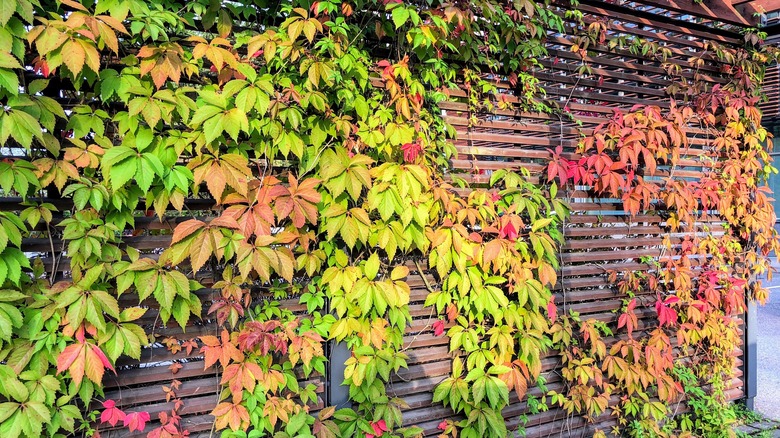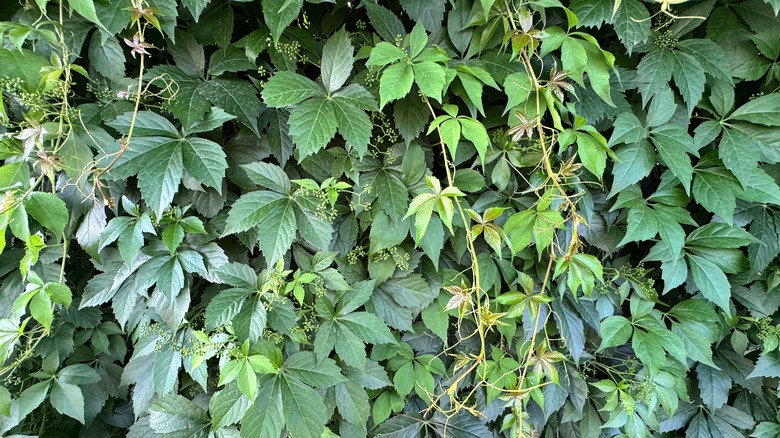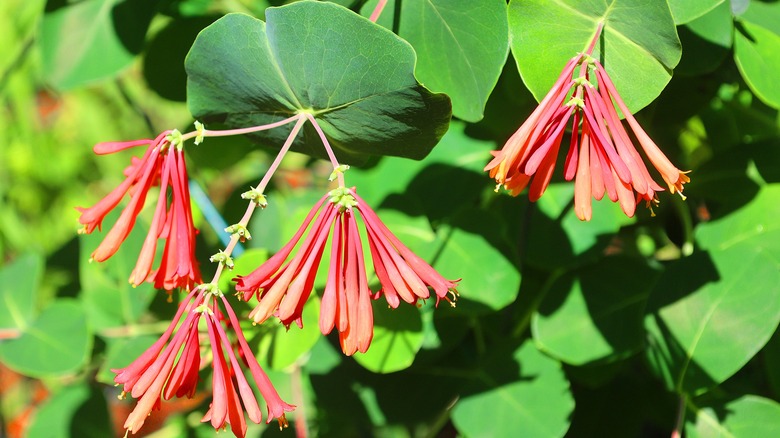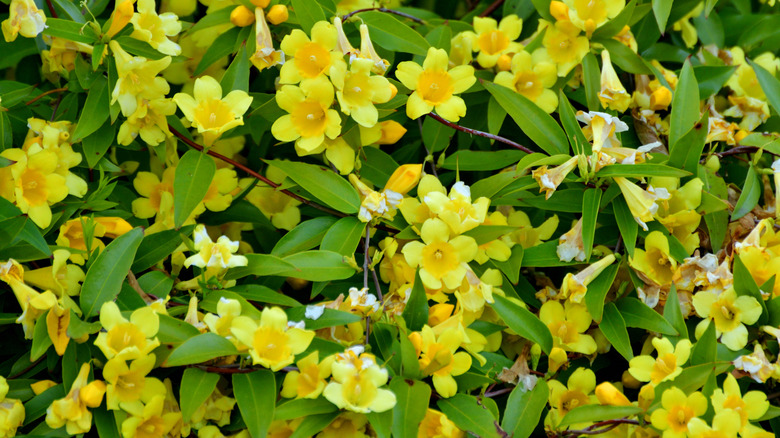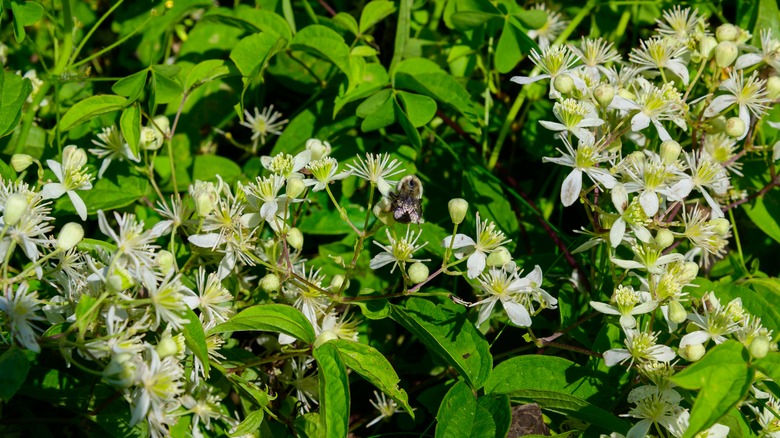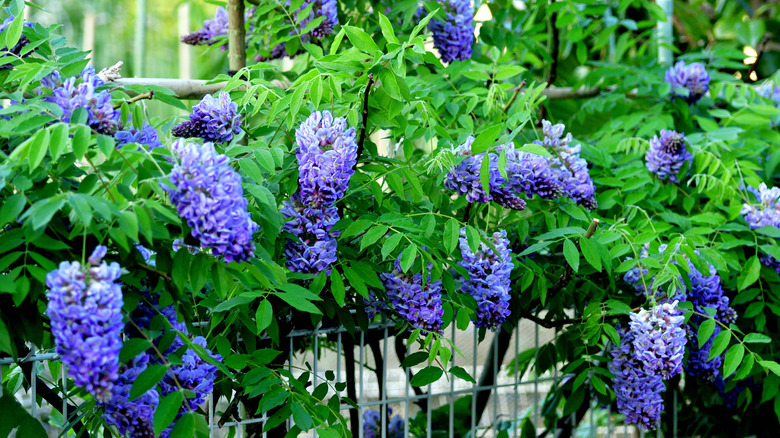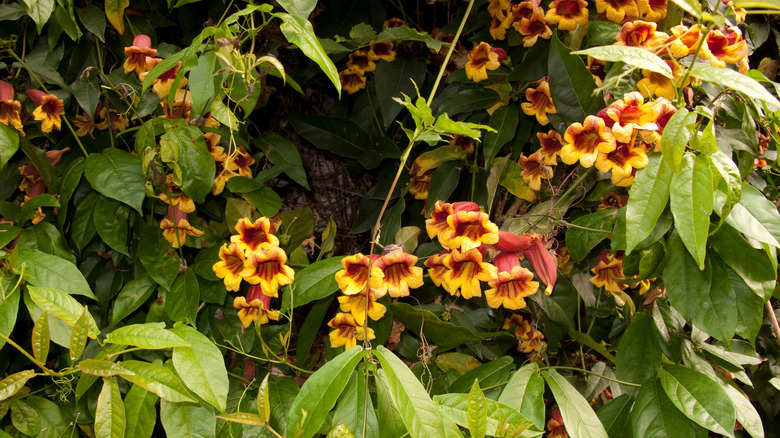7 Climbing Plants That Can Spruce Up A Garden Fence While Adding Privacy
They say that "good fences make good neighbors," but what if that fence is plain or unsightly — or just not quite private enough? Your garden doesn't quite have to end at the fence line. There are a wide variety of visually pleasing climbing plants that can make your backyard feel like a sanctuary while delivering a pop of "wow." Extending your planting onto and up the fence itself can also make a smaller yard or garden feel fuller and livelier.
When selecting an appropriate climbing plant to zhuzh up your fence, there are a few things you should keep in mind. How much light does the area get? What is the soil quality? Additionally, you'll want to take a look at the fence itself and decide if it will be best suited to plants that climb using wrapping tendrils, vines that twine around the support, or plants that cling with adhesive "suction cups" (aerial roots). It's also a good idea to research the growing habits and native habitat of your plant selections to make sure they aren't invasive in your area or aggressive enough that they'll overpower your yard.
Hops
If you have a penchant for home brewing, you're probably already familiar with common hops (Humulus lupulus), whose seed cones can be used to give beer its familiar bitter taste. This perennial climbing bine (not vine!) grows rapidly in the summer — up to a foot a day — then dies back during the winter. Native to Europe, it is considered hardy in USDA Zones 5 through 8. Expect to see plenty of butterflies visiting its white and yellow blooms in the summer and fall. Make sure you're not planting the similar-looking but invasive Japanese hop (Humulus japonicus or Humulus scandens).
Virginia creeper
No, that vine with five saw-toothed leaflets isn't poison ivy — it's Parthenocissus quinquefolia, or Virginia creeper. If your vine leaf identification is shaky, remember the old adage: "Leaves of three, leave it be; leaves of five, let it thrive." Native to the Eastern United States and Mexico, Virginia creeper is a perennial that is winter-hardy in zones 3 through 10 and will happily grow as either ground or vertical surface cover. Its attractive green foliage turns bright red in the fall. Just keep in mind that its blue fruits are poisonous to humans if consumed.
Trumpet honeysuckle
A U.S. native vine common in the South, trumpet honeysuckle (Lonicera sempervirens) is a no-brainer for those courting the attention of hummingbirds and other pollinators. Suited to full sun or partial shade in zones 4 through 9, its foliage can be evergreen in warmer climates (zone 8 and up). In late spring and summer, you can enjoy its brilliant red-orange blooms, and in fall its red berries are still attractive against its blue-green leaves. One caveat: it is quite flammable, so if you live in an area with a high wildfire risk, plant it away from any structures.
Carolina jessamine
Another Southern U.S.A. native, Carolina jessamine (Gelsemium sempervirens), also known as false jasmine or Carolina yellow jasmine, delivers a burst of color and sweet fragrance in spring. It sometimes re-blooms in fall as well. Hardy and evergreen in zones 7 through 10, Carolina jessamine grows well as a fence, wall, or trellis cover, or as ground cover if unsupported. It's beloved of pollinators such as butterflies and hummingbirds for its brilliant yellow trumpet-shaped flowers. If you have little ones or pets running around, be mindful of the fact that its flowers and foliage are toxic if ingested.
Woodbine
Virgin's-bower, old man's beard, woodbine — by any name, Clematis virginiana can be a great choice of fence cover for zones 3 through 8. As its Latin name might suggest, woodbine is native to Virginia and other parts of the Eastern United States. This deer-resistant climbing vine produces sweet-smelling white flowers in the fall, with female plants putting out intriguing feather-like seed heads (hence the common name "old man's beard"). It's fairly unfussy about the amount of light it receives and will still flower beautifully in the shade, unlike many other flowering vines. It is toxic to pets if consumed.
American wisteria
What could be more glamorous than a fence draped in fragrant bunches of purple American wisteria (Wisteria frutescens) blooms? Although growing this U.S. native twining climber can be an exercise in patience — it may take two to three years or longer to bloom for the first time — once established, you can enjoy a spectacular show in the late spring every year. An added bonus: this purple flowering vine is particularly resistant to deer browsing. Hardy in zones 5 through 9, American wisteria favors slightly acidic, loamy soil and requires full sun to really shine during blooming season.
Crossvine
If you need to cover a lot of vertical real estate and want to avoid invasive species such as English ivy (Hedera helix), crossvine (Bignonia capreolata) can be an excellent choice. Native to parts of the midwestern and southeastern U.S., this vigorous grower is hardy in zones 5 through 9. In late winter and early spring, you can enjoy a show of fragrant flowers ranging from yellow to reddish-orange that are very appealing to hummingbirds and insect pollinators. Although it can grow in partial shade, you'll see far more blooms in full sun.
